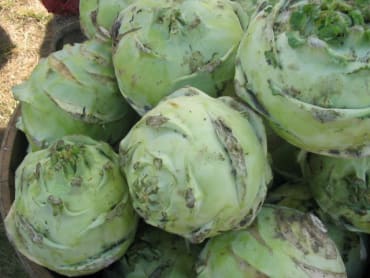(130 days) Open-pollinated. These get enormous, regularly exceeding 10" in diameter and 10 lb. Unlike other kohlrabi, this Czechoslovakian heirloom doesn’t get woody even at such a large size. A root cellar staple, Gigante’s crisp white mildly tangy flesh will add zest to your meals while you await the first edible greens of spring. Staffer Emily Skrobis praises Gigante: “It tastes alive in the dead of winter” and reports that her kohlrabi and carrot slaw is always a hit at potlucks. Sow in spring for late fall harvest. Leaves sweeten like a tender kale after a few hard frosts in the fall and stems likewise become as delicious as their broccoli counterparts. ③
Gigante Kohlrabi
Gigante Kohlrabi
(130 days) Open-pollinated. These get enormous, regularly exceeding 10" in diameter and 10 lb. Unlike other kohlrabi, this Czechoslovakian heirloom doesn’t get woody even at such a large size. A root cellar staple, Gigante’s crisp white mildly tangy flesh will add zest to your meals while you await the first edible greens of spring. Staffer Emily Skrobis praises Gigante: “It tastes alive in the dead of winter” and reports that her kohlrabi and carrot slaw is always a hit at potlucks. Sow in spring for late fall harvest. Leaves sweeten like a tender kale after a few hard frosts in the fall and stems likewise become as delicious as their broccoli counterparts. ③
Additional Information
Kohlrabi
About 100-300 seeds/g.
Don’t like kohlrabi? Try harvesting it young. Its texture turns tough, woody and inedible if you wait too long. Use wire hoops and row cover to keep flea beetles out.
Brassicas
Days to maturity are from seedling emergence. Subtract 20 days for transplants.
Culture: Start brassicas indoors March-May for setting out May-July, or direct-seed in May, or in June for fall crop. Minimum germination soil temperature 40°, optimal range 55–85°. Easier grown for the fall because many varieties perform poorly in hot summers. For better stands in dry conditions, sow in trenches and keep irrigated. Wire hoops and row cover should be used at early stages to keep out flea beetles and swede midge.
Note: because of a rule issued by Oregon, we cannot ship brassica packets larger than ½ oz. (14 grams) into the Willamette Valley, except those that have tested negative for Black Leg and Black Rot. Check descriptions for information.
Diseases:- BL: Blackleg
- BR: Black Rot
- BS: Bacterial Speck
- DM: Downy Mildew
- FW: Fusarium Wilt
- FY: Fusarium Yellows
- TB: Tipburn
- WR: White Rust
Pest and Disease Remedies for all Brassicas
Major pests: Cabbage Looper, Diamondback Moth, Imported Cabbageworm
Cultural controls: control cabbage-family weeds near crop fields, till under crop debris of early-season brassicas after harvest.
Material controls: Spinosad, Bt.
Pest: Flea Beetle
Cultural controls: floating row covers, mulch with straw, time plantings for fall harvested crops only, crop rotation, perimeter trap cropping.
Material controls: AzaMax, Spinosad, PyGanic.
Pest: Cabbage Root Maggot
Cultural controls: time planting to avoid first hatching, use row covers, control weeds.
Major diseases: Black Rot, Alternaria Leaf Spot, Blackleg, Club Root, Downy Mildew, White Mold
Cultural controls: avoid transplanting plants with yellow leaves or v-shaped lesions, crop rotation, destroy crop debris after harvest, avoid overhead irrigation, control weeds, allow for good air movement.
Material controls: Copper.
Disease: Head Rot
Cultural controls: use well-domed varieties, harvest heads when tight, cut stalks at an angle.
Material control: Copper.
Swede Midge—not as cute as it sounds!
Alert! Heading brassicas in the Northeast are seeing consistent damage from swede midge, a tiny gall midge. Its effects result in a non-heading plant. Wire hoops and row cover at early stages of heading brassica crops are becoming crucial for success. Some research also suggests garlic sprays as a possible organic repellent. Consult your Cooperative Extension resources for further information.
Germination Testing
For the latest results of our germination tests, please see the germination page.
Our Seeds are Non-GMO

All of our seeds are non-GMO, and free of neonicotinoids and fungicides. Fedco is one of the original companies to sign the Safe Seed Pledge.




